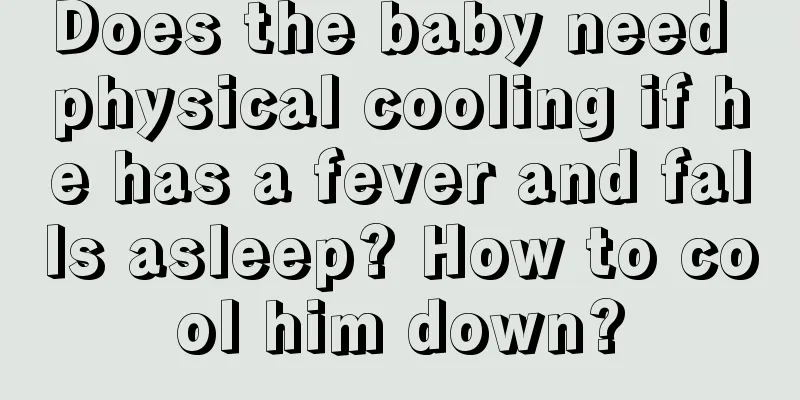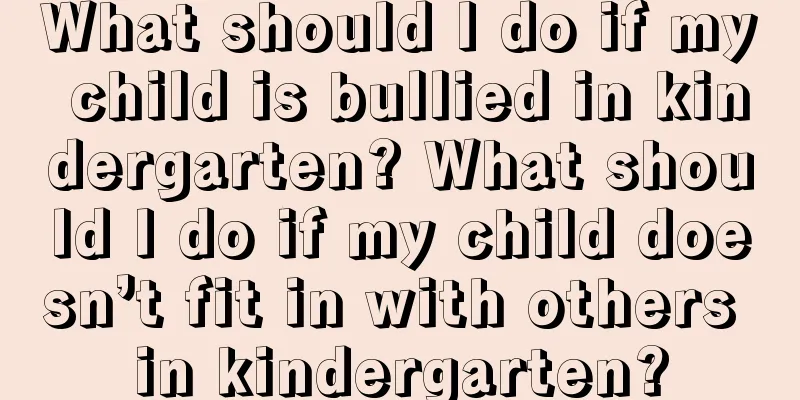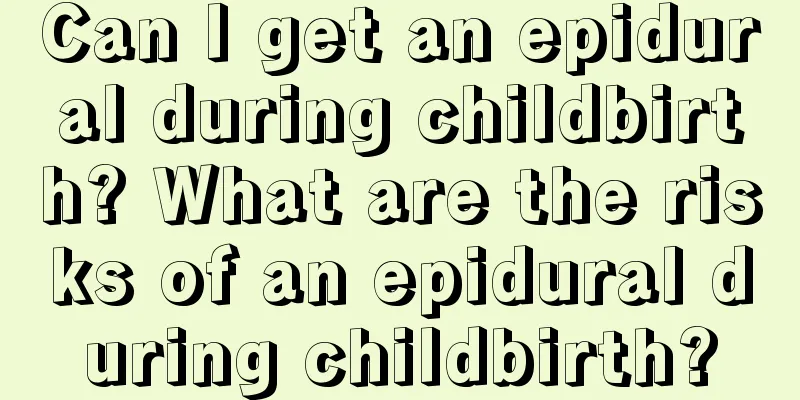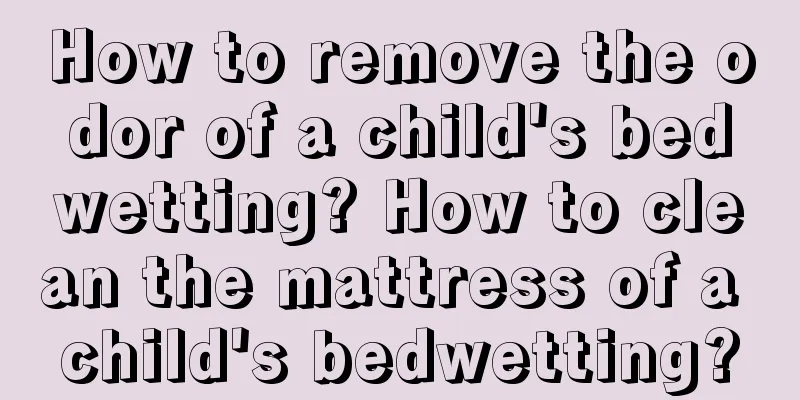Does the baby need physical cooling if he has a fever and falls asleep? How to cool him down?

|
When the baby has a fever and is asleep, should the mother wake the baby up to cool him down physically? What are the methods of physical cooling? The editor of No. 5 website has summarized some methods for you to learn from~ If the baby has a fever and falls asleep, does physical cooling still need to be done?If necessary, use a fever-reducing patch to cool the baby down. It will not affect the baby's rest. When sleeping, keep the baby's hands and feet out and do not cover them too thickly. Heat dissipation is the first priority during the fever stage. Pay attention to measuring the temperature every half an hour. If it is 38.5 degrees, you can take medicine. If it is 39 degrees, you need to see a doctor. What symptoms should children take to the hospital in time after they have a cold or fever?1. High fever above 39.5℃. 2. The child is unable to drink water or has convulsions. 3. The child is in poor spirits, sleepy or difficult to wake up. 4. The child has a wheezing sound in the throat when breathing. 5. After a cold, the child's breathing speeds up (infants under 2 months old breathe ≥60 times per minute, children from 2 months to 1 year old breathe ≥50 times per minute, children from 1 to 4 years old breathe ≥40 times per minute), which may cause mild pneumonia. 6. The child's breathing speeds up and the upper chest is sunken (the lower chest wall is sunken when the child inhales, which is due to the poor elasticity of the lung tissue and the difficulty in inhaling; if only the soft tissue between the ribs or above the clavicle is sunken when the child inhales, it is not chest sunken). This feature indicates that the child has obvious breathing difficulties and may have severe pneumonia. Fever is the result of the battle between the human body's defense system and foreign invading pathogens. The higher the fever, the stronger the body's resistance ability, but it does not mean that the disease is more serious. Infants and young children under three months old have not yet fully developed immune functions and weak resistance, so even if they have severe pneumonia, they rarely have a high fever. A common example of high fever is roseola infantum, which is common in infants aged 6-9 months. The body temperature is usually above 39 degrees and the fever lasts for three days. However, the child is usually in good spirits, the body temperature subsides within 72 hours, a red rash appears on the face and trunk, and the rash disappears and heals in 2-3 days, with almost no sequelae. At the same time, fever is also a self-protection mechanism. Fever can effectively inhibit the growth and reproduction of pathogens and reduce damage to the human body. The most suitable growth temperature for most pathogenic microorganisms is 37 degrees. When the temperature rises, the pathogen's reproduction ability will be significantly reduced. Don't rush to reduce your body temperature to normal! High fever also has its negative side, which can cause metabolic disorders and dysfunction of various systems, leading to damage to important organs. Because the nervous system of children is not fully developed, especially those under 5 years old, they are prone to convulsions when they have a fever, which can cause varying degrees of damage to the brain. Therefore, children with fever, especially high fever, should be treated promptly to reduce fever. What measures should mothers take to help their babies lower their body temperature?The temperature center of infants and young children is not fully developed yet. If they encounter respiratory infections, allergies, vaccination reactions, etc., their body temperature will rise, but they cannot use medicines indiscriminately. So when the baby has a fever or a high fever that does not subside, what measures should the mother take to help the baby lower his body temperature? 1. 35% alcohol bath Alcohol can dilate blood vessels and take away a lot of heat when evaporating. It can help cool down infants and young children when they have a fever. Prepare 100 ml of 75% alcohol and add an equal amount of warm water. Keep the temperature at around 27-37 degrees Celsius. Do not overcool it, otherwise it will cause muscle contraction and cause the fever to rise again. When using alcohol bath, use a small towel to wipe from the baby's neck, from top to bottom, in a patting manner. Rub the axilla and groin areas with rich blood vessels until the skin turns slightly red, which is conducive to cooling. Be careful not to wipe the baby's chest, abdomen, and soles of the feet to avoid adverse reactions. 2. Take a warm bath Bathing can help dissipate heat. If your baby is in good spirits when he has a fever, you can bathe him more often, and adjust the water temperature to 27-37 degrees Celsius. Be careful not to give your baby a hot bath, otherwise it will easily cause systemic vasodilation, increase oxygen consumption, easily lead to ischemia and hypoxia, and aggravate the condition. 3. Soak your feet in hot water Soaking the feet can promote blood circulation and relieve discomfort. Another benefit of soaking the feet when the baby has a fever is that it can help cool down the baby. You can use a large basin or a small bucket to soak the feet. Pour 2/3 of the basin with water. The water temperature should be slightly higher than usual, about 40 degrees Celsius, and the baby should be able to adapt to it. When soaking the feet, the mother can rub the baby's two little feet, which can not only dilate the blood vessels, but also relieve the discomfort caused by the fever. 4. Use ice packs You can go to the store to buy chemical ice packs, put them in the refrigerator to freeze, take them out after they turn from gel to solid, wrap them in a towel and apply them to the baby's head, forehead, neck, armpits, groin, etc., which can be used repeatedly. You can also make your own ice packs at home: use disposable medical silicone gloves to water and tie them into knots and put them in the freezer. Take them out after they freeze into solid. If you feel that the ice is too cold, you can take out the ice pack when it is half ice and half water, wrap it in a towel and apply it to the baby. 5. Ice pillow When your baby has a high fever, you can make an ice pillow for him to use. It is comfortable and effective. Go to the hospital and buy an ice bag (not a hot water bag). Pour the ice cubes into a basin, break them into small pieces, rinse them with water to remove the edges and corners, put them into the ice bag, add 50-100 ml of water, do not fill it up, 2/3 full is enough, exhaust the air, clamp the bag mouth, wrap it with cloth or towel and place it under the baby's head and neck as a pillow. When the ice cubes melt, you can replace them, and the baby's body temperature will soon drop. Do not use the medicine for more than 3 daysThe doctor said that after the child has symptoms such as fever, many parents will cover their children tightly in order to make them sweat, which can easily cause febrile convulsions, which are more common in children aged 6 months to 3 years, and manifested by convulsions, clenched jaws, foaming at the mouth, etc. "For some children who have had febrile convulsions when they have a cold, parents should closely observe their body temperature changes. Once the body temperature reaches above 38°C, they should actively reduce the fever." "When children use antipyretics, they should not take them continuously for more than 3 days, and special attention should be paid when choosing medicines." The doctor said that the liver and kidney functions of infants and young children are immature, so they must not take adult antipyretics. They should choose medicines with small side effects and relatively mild efficacy. If the child's temperature does not go down after taking antipyretics for 3 days, he or she should seek medical attention as soon as possible. The diet is mainly liquid or semi-liquid The doctor said that generally when children have a fever, their diet should be mainly liquid or semi-liquid food, such as milk, rice soup, mung bean soup, low-fat meat soup and various fresh fruit juices. If the child's body temperature drops and his appetite improves, he can change to a semi-liquid diet, such as rice porridge, egg custard, etc. In addition, children with cough and phlegm often swallow the phlegm because they cannot cough it up. Severe coughing can also cause stomach discomfort. If they eat too much, they are prone to vomiting. Parents should pay special attention to not letting children eat too much, and not giving them seafood or overly salty or greasy dishes to prevent allergies or respiratory irritation, which can aggravate the symptoms. |
<<: Will massaging the belly of a pregnant woman speed up the fetus' entry into the pelvis?
Recommend
Why does the baby keep wanting to breastfeed when he has bloating? What should I do if the baby keeps wanting to breastfeed when he has bloating?
The stomach and intestines of babies who have jus...
Will my mother's myopia be passed on to her children? Will my mother's myopia be passed on to her children?
Will myopia be inherited by the mother? Today, I ...
What is a good name for a baby born on Chinese Valentine's Day in 2017? A complete list of baby names born on Chinese Valentine's Day in 2017
What is a good name for a baby born on Chinese Va...
What are the symptoms of zinc deficiency in children and what causes it
Many children suffer from zinc deficiency because...
Why does a pregnant woman have diarrhea after eating pears? What can I eat if I have stomach pain during early pregnancy?
First-time pregnant mothers will be somewhat at a...
Can pregnant women use a warm pack? Will it affect the baby's health?
Pregnant women have many taboos in life, so, can ...
How to treat Trichomonas vaginitis before pregnancy
Trichomonas vaginitis troubles many female friend...
What clothes should babies wear in October? What clothes should babies wear in October?
In October every year, the weather has changed si...
Does painless childbirth have any effect on the baby? Does painless childbirth have any side effects?
Many people must have heard of painless childbirt...
Signs of successful frozen embryo transfer Precautions after frozen embryo transfer
Frozen embryo transfer is an important step in th...
2017 Kindergarten Outdoor Activities Lesson Plan 2017 Kindergarten Sports Meeting Plan
2017 Kindergarten Outdoor Activities Lesson Plan ...
Can pregnant women use moxa fumigation? Can pregnant women use laser to remove freckles?
Fumigation with moxa is a very healthy Chinese me...
How to make your baby sleep longer at night without waking up
Newborns need regular sleep after birth, and what...
Why can't the electric toothbrush be charged? Can the elderly use electric toothbrushes?
An electric toothbrush can be used for about two ...
How to open Liby dishwashing liquid? Which type of Liby dishwashing liquid is the best?
Liby dishwashing liquid is something that everyon...









